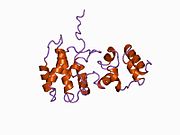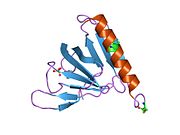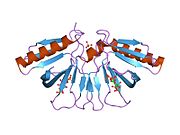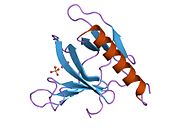From Wikipedia, the free encyclopedia
Protein-coding gene in the species Homo sapiens
Cytohesin-3 is a protein that in humans is encoded by the CYTH3 gene .[ 5] [ 6]
This gene encodes a member of the cytohesin (CYTH) family, formerly known as the PSCD (pleckstrin homology, Sec7 and coiled-coil domains) family. Cytohesin family members have identical structural organization that consists of an N-terminal coiled-coil motif, a central Sec7 domain, and a C-terminal pleckstrin homology (PH) domain. The coiled-coil motif is involved in homodimerization, the Sec7 domain contains guanine-nucleotide exchange protein (GEP) activity, and the PH domain interacts with phospholipids and is responsible for association of CYTHs with membranes. Members of this family appear to mediate the regulation of protein sorting and membrane trafficking . This encoded protein is involved in the control of Golgi structure and function, and it may have a physiological role in regulating ADP-ribosylation factor protein 6 (ARF) functions, in addition to acting on ARF1.[ 6]
^ a b c GRCh38: Ensembl release 89: ENSG00000008256 – Ensembl , May 2017^ a b c GRCm38: Ensembl release 89: ENSMUSG00000018001 – Ensembl , May 2017^ "Human PubMed Reference:" . National Center for Biotechnology Information, U.S. National Library of Medicine .^ "Mouse PubMed Reference:" . National Center for Biotechnology Information, U.S. National Library of Medicine .^ Klarlund JK, Guilherme A, Holik JJ, Virbasius JV, Chawla A, Czech MP (Apr 1997). "Signaling by phosphoinositide-3,4,5-trisphosphate through proteins containing pleckstrin and Sec7 homology domains". Science . 275 (5308): 1927–30. doi :10.1126/science.275.5308.1927 . PMID 9072969 . S2CID 40523716 . ^ a b "Entrez Gene: PSCD3 pleckstrin homology, Sec7 and coiled-coil domains 3" .
Franco M, Boretto J, Robineau S, et al. (1998). "ARNO3, a Sec7-domain guanine nucleotide exchange factor for ADP ribosylation factor 1, is involved in the control of Golgi structure and function" . Proc. Natl. Acad. Sci. U.S.A . 95 (17): 9926–31. Bibcode :1998PNAS...95.9926F . doi :10.1073/pnas.95.17.9926 PMC 21438 PMID 9707577 . Venkateswarlu K, Gunn-Moore F, Oatey PB, et al. (1998). "Nerve growth factor- and epidermal growth factor-stimulated translocation of the ADP-ribosylation factor-exchange factor GRP1 to the plasma membrane of PC12 cells requires activation of phosphatidylinositol 3-kinase and the GRP1 pleckstrin homology domain" . Biochem. J . 335 ( Pt 1) (Pt 1): 139–46. doi :10.1042/bj3350139 . PMC 1219762 PMID 9742223 . Ogasawara M, Kim SC, Adamik R, et al. (2000). "Similarities in function and gene structure of cytohesin-4 and cytohesin-1, guanine nucleotide-exchange proteins for ADP-ribosylation factors" . J. Biol. Chem . 275 (5): 3221–30. doi :10.1074/jbc.275.5.3221 PMID 10652308 . Nevrivy DJ, Peterson VJ, Avram D, et al. (2000). "Interaction of GRASP, a protein encoded by a novel retinoic acid-induced gene, with members of the cytohesin family of guanine nucleotide exchange factors" . J. Biol. Chem . 275 (22): 16827–36. doi :10.1074/jbc.275.22.16827 PMID 10828067 . Strausberg RL, Feingold EA, Grouse LH, et al. (2003). "Generation and initial analysis of more than 15,000 full-length human and mouse cDNA sequences" . Proc. Natl. Acad. Sci. U.S.A . 99 (26): 16899–903. Bibcode :2002PNAS...9916899M . doi :10.1073/pnas.242603899 PMC 139241 PMID 12477932 . Scherer SW, Cheung J, MacDonald JR, et al. (2003). "Human Chromosome 7: DNA Sequence and Biology" . Science . 300 (5620): 767–72. Bibcode :2003Sci...300..767S . doi :10.1126/science.1083423 . PMC 2882961 PMID 12690205 . Hillier LW, Fulton RS, Fulton LA, et al. (2003). "The DNA sequence of human chromosome 7" . Nature . 424 (6945): 157–64. Bibcode :2003Natur.424..157H . doi :10.1038/nature01782 PMID 12853948 . Ota T, Suzuki Y, Nishikawa T, et al. (2004). "Complete sequencing and characterization of 21,243 full-length human cDNAs" . Nat. Genet . 36 (1): 40–5. doi :10.1038/ng1285 PMID 14702039 . Gerhard DS, Wagner L, Feingold EA, et al. (2004). "The Status, Quality, and Expansion of the NIH Full-Length cDNA Project: The Mammalian Gene Collection (MGC)" . Genome Res . 14 (10B): 2121–7. doi :10.1101/gr.2596504 . PMC 528928 PMID 15489334 . Poirier MB, Hamann G, Domingue ME, et al. (2005). "General receptor for phosphoinositides 1, a novel repressor of thyroid hormone receptor action that prevents deoxyribonucleic acid binding" . Mol. Endocrinol . 19 (8): 1991–2005. doi :10.1210/me.2004-0449 PMID 15878955 . Rual JF, Venkatesan K, Hao T, et al. (2005). "Towards a proteome-scale map of the human protein-protein interaction network". Nature . 437 (7062): 1173–8. Bibcode :2005Natur.437.1173R . doi :10.1038/nature04209 . PMID 16189514 . S2CID 4427026 .
PDB gallery
1bc9 : CYTOHESIN-1/B2-1 SEC7 DOMAIN, NMR, MINIMIZED AVERAGE STRUCTURE
1fgy : GRP1 PH DOMAIN WITH INS(1,3,4,5)P4
1fgz : GRP1 PH DOMAIN (UNLIGANDED)
1fhw : Structure of the pleckstrin homology domain from GRP1 in complex with inositol(1,3,4,5,6)pentakisphosphate
1fhx : Structure of the pleckstrin homology domain from GRP1 in complex with inositol 1,3,4,5-tetrakisphosphate
1u2b : Triglycine variant of the Grp1 Pleckstrin Homology Domain unliganded












